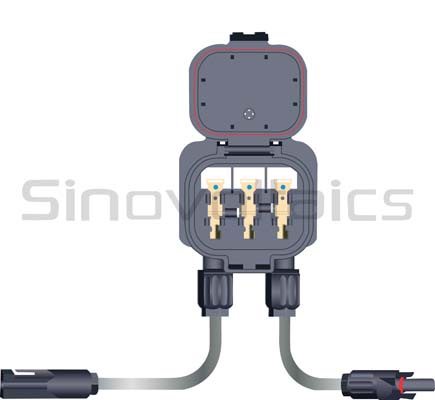IP Ratings for solar junction boxes: IEC 529, IP 65, IP 67
The majority of solar junction boxes have at least an IP 65 rating, while the quality junction boxes have an IP 67 rating. This article explain the meaning of both IP 65 standard and the IP 67 standard and describes the IEC 529 standard as well.
IEC 529: Ingress Protection Standard
The International Electro-technical Commission (IEC), a globally recognized international standards and conformity assessment body, came up with a standard to define adequate protection of enclosures against the ingress of dust or water. The IEC 529 (BSEN60529:1991) standard codified the ingress tolerance of many enclosures and boxes used in electrical industry. The IP rating of an enclosure is a two digit numeric code that tells you how resistant a particular box is to dust and fluid ingress. IP is an acronym used for Ingress Protection. The rating consists of the IP abbreviation (IP) followed by a two digit code. Each digit represents the degree of tolerance against one of the environmental factors. T he first digit is the degree of tolerance against solid particles ingress while the second digit shows the same for liquid particle ingress.
 IP 65 and IP 67 rating for junction boxes
IP 65 and IP 67 rating for junction boxes
Meaning of the digits used in an IP Code
The following tables clearly illustrate what the digits in the code stand for. Specific examples are also given for better understand of the degree of protection.
| Index | Protection against | Examples |
| 0 | No Protection | No Protection |
| 1 | Large foreign bodies, diam. >50mm | Accidental touch from the back of hand |
| 2 | Medium-sized foreign bodies, diam. >12 | Touch by finger |
| 3 | Small foreign bodies, diam. >2.5mm | Accidental impact from tools and wires |
| 4 | Granular foreign bodies, diam. >1mm | |
| 5 | Dust protected | Dust deposits are permitted, but their volume must not affect the functioning |
| 6 | Dust-proof | Complete Protection |
While Table 1 (above) lists specific protection against various forms of solid ingress, Table 2 (below) lists specific protection against various forms of liquid ingress.
| Index | Protection against | Examples |
| 0 | No Protection | No Protection |
| 1 | Water dripping/falling vertically | Condensation/Light rain |
| 2 | Water sprayed at an angle (up to 15º degrees from the vertical) | Light rain with wind |
| 3 | Spray water (any direction up to 60º degrees from the vertical) | Heavy rainstorm |
| 4 | Spray water from all directions, (limited ingress permitted) | Splashing |
| 5 | Low pressure water jets from all directions, (limited ingress permitted) | Hose down, residential |
| 6 | High pressure jets from all directions, (limited ingress permitted) | Hose down, commercial.e.g. Ship decks |
| 7 | Temporary immersion, 15 cm to 1m | Immersion in tank |
| 8 | Permanent Immersion, under pressure | For use on Titanic recovery vehicle |
Explanation IP 65 and IP 67o solar junction box IP Code
After understanding what each digit in the IP code stands for, let’s have a look at the most common IP ratings for solar junction boxes. Nowadays the majority of junction boxes have at least an IP65 ratings, while the quality junction boxes have an IP67 rating.
So what do IP65 and IP67 protection ratings mean?
EXAMPLE 1: IP 65
IP=Ingress Protection against 6 = From Table 1, “Dust protection” 5 = From Table 2, “Low Pressure Water Jets from all directions” A junction box with a IP 65 rating will provide protection against Dust and Low pressure water jets. There may be limited ingress inside, but it won’t stop the component from properly functioning.
EXAMPLE 1: IP 67
IP=Ingress Protection against 6 = From Table 1, “Dust protection” 7 = From Table 2, “Temporary immersion, 15cm to 1m.” This tells you that a solar junction box with an IP67 rating will provide complete protection against Dust and will properly function after Temporary immersion in water.

Ranga Rao Naidu
on 18 Jan 2016Niclas
on 20 Jan 2016Oni
on 13 Jul 2016Niclas
on 19 Jul 2016PRAKASH.K
on 23 Feb 2019